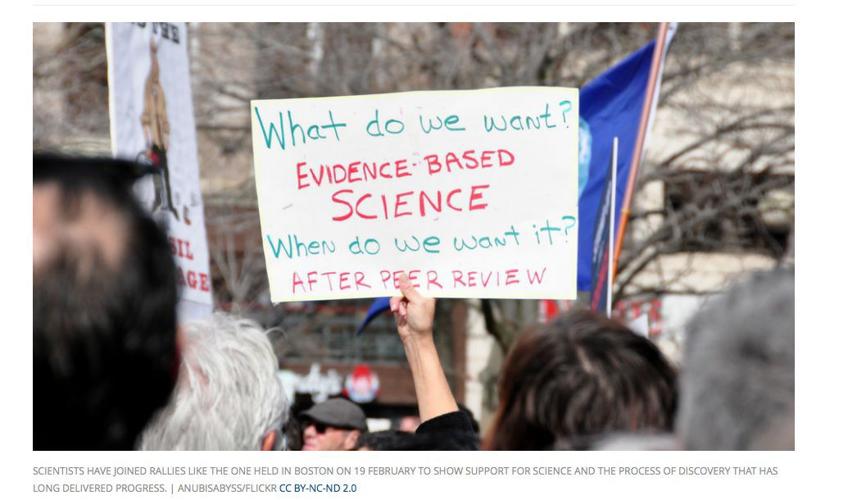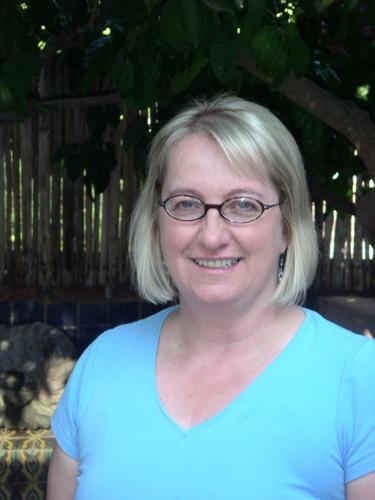As the March for Science movement grows, so does the debate among scientists about their role in public policy.
A photo on the webpage of the American Association for the Advancement of Science nicely illustrates the dilemma.
A woman holds a sign that reads: тWhat do we want? Evidence-based science. When do we want it? After peer review.т
Not exactly a rousing call for immediate action.
The photo accompanies the Thursday announcement by the association, the worldтs largest scientific organization, of its affiliation with the тMarch for Scienceт movement.
As some scientists and supporters prepare to march, others are concerned about the message that march will send.
Some worry it will be interpreted as a strictly partisan act in opposition to the Trump administration, and some feel that the date of the march т on Earth Day, April 22 т will lead to an interpretation that it is strictly about climate change.
People are also reading…
тItтs scheduled for Earth Day. It seems set up to polarize,т said climate scientist Jonathan Overpeck at a recent talk on тDeconstructing the Science-Policy Interface in a Post-Truth Era.т
Geoscientist Diana Liverman said she supports the march and hopes it is not just scientists in the streets. тI hope a lot of others will march with them,т she said.
The seminar speaker, David Cash, of the University of Massachusetts, said the change in administration has come at a time тin which fact and truth seem much more malleable than they were in the past.т
At a panel on тScience in the Age of Trumpт at the annual association meeting last week, John Holdren, former science adviser to President Obama, said he feared massive cuts for science, particularly in the environmental field with тa president who resists facts that donтt comport with his pre-determined views.т
Still, Holdren said, he was unsure that marching is the way to go. тThe March for Science could work against us if we come across as elitist т worse, if we come across as partisan,т said Holdren during a televised session.
Marches for science are now scheduled in more than 150 cities around the world, to coincide with the original march in Washington, D.C., according to the organizationтs website.
In УлшжжБВЅ, marches are being planned in УлшжжБВЅ, Phoenix, Flagstaff and Show Low.
The УлшжжБВЅ march, originally planned for Himmel Park and the University of УлшжжБВЅ Mall, will now take place between the city of УлшжжБВЅтs DeAnza and El Presidio parks.
Himmel Park will be jammed with a soccer tournament that day, said march organizer Josh Hoskinson. The UA, meanwhile, did not explicitly discourage the group, but put up тa lot of hoops to jump through,т Hoskinson said.
UA spokesman Chris Sigurdson said the UA didnтt discourage the march, but made the group aware of the logistical problems it would need to overcome. The UA has no position on the march, he said, and regards the campus as a public square. тWe have people march on campus all the time,т he said.
Hoskinson said his group is committed to the march being about science, not politics. тThis is definitely not a march against Trump or the Trump administration. We would love to work with the Trump administration.т
The group has lined up about 20 scientific organizations to set up booths at El Presidio Park and is soliciting more organizations and volunteers, he said.
At a conference on тScience Diplomacy and Policy,т held by the University of УлшжжБВЅ College of Engineering last week, the discussions were more global but the same questions arose.
Marga Gual Soler said scientists canтt be content to conduct research and issue reports when it comes to having an impact on policy. тThe facts donтt speak for themselves. The conversation between people is the important part.т
Gual Soler, a project director in the associationтs Center for Science Diplomacy, said thatтs especially true in the international arena where scientific exchanges are an effective form of diplomacy.
She pointed to recent agreements between the United States and Cuba on medical issues in the fields of neuroscience, cancer and vector-borne diseases as examples.
Sergio Pastrana, executive director of the Academy of Sciences of Cuba, said scientific exchanges with the United States remained strong through the Fidel Castro years and the 50-year U.S. embargo on trade and travel.
In his presentation, Pastrana noted that Castro embraced science, particularly medical science, as a way of ridding the island of malaria and providing a high level of health care.
As a result, Pastrana said, Cuba тhas a level of health equivalent to the U.S. and Canada with the GDP of Bangladesh.т
Peter Agre, a Nobel-prize winning medical researcher from Johns Hopkins University, said exchanges of medical programs and information have brought him over the years to countries such as Iraq, Myanmar and North Korea where scientific exchanges continued despite a lack of diplomatic ones.
The assimilation of science into policy isnтt quick, said Michael Clegg, a biologist and former foreign secretary of the National Academy of Sciences. The processes are slow and the public understanding is weak, he said.
And while scientists narrowly define their studies within single fields, тpolicy makers need broad synthesis.т
One of his concerns today is that тContemporary populist movements see science as part of the elite order.т
While the UA has no position on the march, its employees are certainly free to march and to provide тfactual informationт in their roles as experts, said Sigurdson. They are free to advocate for a position, but should make clear they are doing so as individuals, he said.
















